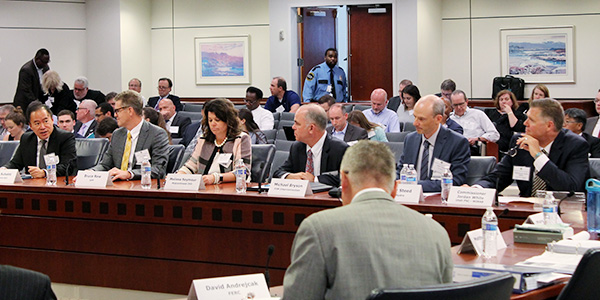By Michael Brooks
WASHINGTON — CAISO, SPP and BC Hydro officials reassured FERC on Thursday that the Western Interconnection’s transition from two reliability coordinators to five is going smoothly and that everything will be ready by the time Peak Reliability closes shop Dec. 3.
“We are ready,” Dede Subakti, CAISO director of operations engineering services, told the commission at its annual technical conference on reliability. “That’s probably the reason they allowed me to go out of the office and I’m here now.”
CAISO’s new RC West, which received its NERC certification May 30, will take over providing RC services from Peak for the ISO, several California municipal utilities and a northern sliver of Baja California at the U.S.-Mexico on Monday. It will take on most of Peak’s territory elsewhere in the West on Nov. 1.
Meanwhile, BC Hydro will assume responsibility for its own footprint on Sept. 2, and SPP will take over the remainder of Peak’s territory on Dec. 3. (See New RCs Tell WECC Transition on Schedule.)
Differences Add Complexity
The officials did acknowledge complications surrounding the transition. One of the primary functions of an RC is to work with other RCs to respond to threats to reliability, and each of the new providers is unique: an ISO, an Eastern Interconnection-based RTO and a Canadian provincial utility. Learning each other’s set of terms and functions has been important, they said.
“SPP is in a unique position” as an RC provider in both interconnections, said Bruce Rew, vice president of operations for the RTO. “Understanding the distinctive operation of each neighboring RC allows us to establish a framework for coordinating congestion between two or more RCs.”
The panel included officials from MISO and PJM to talk about their experiences developing the RTOs’ joint operating agreement. PJM Vice President of Operations Mike Bryson talked about the challenges of creating seams agreements with different entities — MISO, the Tennessee Valley Authority, NYISO and Southern Co. — that don’t necessarily share the same functions as his RTO. He expressed how “I love the fact that I’m the RC, the BA [balancing authority] and the TOP [transmission operator]. But I get that’s kind of unusual.”
Commissioner Cheryl LaFleur noted that all Eastern Interconnection market operators also performed all three functions — but Rew and Melissa Seymour of MISO noted that their respective RTOs were not TOPs.
LaFleur seemed stunned. “This is how complicated this is,” she said. “This should be FERC 101.”
Commissioner Richard Glick asked if it wasn’t just simpler to have one RC. “It seems to me you’re just increasing the risk, even if you have all these seams agreements and do everything properly,” he said.
“My perspective to everything is that there is a pro and a con to it,” Rew replied. The pro of having a single RC is you don’t have to worry about seams or communication between multiple entities, he said. But “with multiple RCs, you have multiple eyes looking at” problems. “It gives you the opportunity to ask your neighbor, ‘What are you doing about this?’” He recalled as an example the Jan. 17, 2018, cold snap in the South, which led MISO to call a maximum generation alert. (See “SPP, MISO Discuss Jan. 17 ‘Big Chill,’” SPP Briefs: Week of July 9, 2018.)
“That was a wide-area issue, and it affected four RCs,” Rew said. “So we had four RCs working on that. … Just think if that was one RC, that would have been very challenging to have the resources and the ability to manage the widespread problem area.”
Common Tools
The new RCs stressed that they are using many of the same tools as Peak, which has helped in the transition.
In shadowing Peak, RC West has been able to check the accuracy of the tools, Subakti said. “We find that having two RCs in there brings us to a situation where iron sharpens iron,” he said. “We start asking ourselves, ‘Why did we do it this way?’ … It’s actually uncovered a lot of improvements.”
But Utah Public Service Commissioner Jordan White, speaking on behalf of the Western Interconnection Regional Advisory Body (WIRAB), said his organization was concerned about the potential loss of one tool he said has received little attention from the new RCs”: Peak’s performance metrics. Peak uses the metrics not only to keep itself honest, but to measure the level of information provided by the BAs and TOPs.
RC West is developing its own metrics, but WIRAB wants the commission and NERC to encourage the new providers to work together to establish consistent ones. “Consistent metrics across the RCs will not only provide the necessary data to improve reliability; they will demonstrate if reliability has diminished during this transition,” White said.
“Are Peak’s reliability metrics the absolute fundamental right way to go? Not necessarily,” he said. “We do think they’re a good starting place … but what we’re really looking for is a discussion among the RCs about what those best practices are.”






